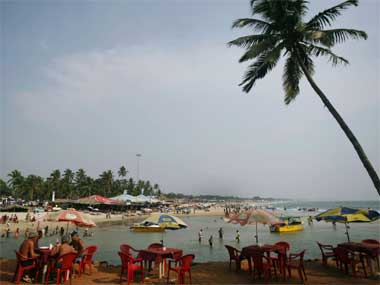by Mayabhushan Nagvenkar
Panaji: While the beaches and cheap holiday prospects in Indonesia and Thailand are spiriting away tourists from Goa’s over-priced coast and over-exposed sandy shores, scientists have now found that crude oil discharged by ships carrying South East Asian crude are now wrecking the western Indian state’s beaches.
Firstpost has in its exclusive possession a study conducted by the Goa-based National Institute of Oceanography (NIO), which has finally cracked the mysterious phenomenon of tar balls, pudding-like balls of tar formed by the mixing of crude oil with sea water, which often line up Goa’s beaches and threatens tourism prospects here. So much so, that tourism authorities here are forced to respond to the tar-ball ‘invasion’ with an almost war-like urgency, hiring an army of sweepers and cleaners to wipe the beaches clean off the tar balls, which imparts an oil-like smell to the water and deters tourists from a swim and a beach stroll.
[caption id=“attachment_895479” align=“alignleft” width=“380”]  Reuters[/caption]
“It is concluded that the tar balls that were deposited along the Goa coast during 2010 and 2011 are formed from the tanker-wash derived oil spills and have the characteristics of floating tar balls,” says the NIO research report which was published an international journal ‘Marine Pollution Bulletin’ published by Elsevier.
The report now wants the strict vigil on the Western Indian coastline to ensure that trans-oceanic ships and tankers do not dump waste oil and discharge ballast water, which pollutes Goa’s beaches, that see over 2.6 million visitors annually from India and across the world.
The study was conducted by top marine scientists at the NIO, which operates under the aegis of the Council for Science and Industrial Research (CSIR). Using unique fingerprinting technique, the report tracked down the origin of the oil spill to one source thousands of nautical miles away in South East Asia.
“Compound Specific Isotope ? 13C analysis brought out a clear representation that all the tar balls samples are from a single source, but not from BH (Bombay High, as it was earlier presumed). The cross-plot of hopane biomarker diagnostic ratios also confirms that the source is SEACO (South East Asia Crude Oil),” the report states.
“The Middle East countries on the north-west of the Arabian Sea are rich in oil producing fields. But, there is a good demand for SEACO in these countries. The SEACO oil is transported to the Middle East countries through the Arabian Sea. It is possible that the tankers that are going to the Middle East with SEACO are likely to clean the tanks in the Arabian Sea. The resulting oil undergoes weathering process, leading to tar-ball formation,” the study states.
Once released into the sea, the tar-balls get caught in the south west monsoon swell and move towards the western coast, specifically Goa.
“(They) eventually deposit on the nearby beaches in consistence with the circulation pattern,” the study observes.
Sample of tar-balls had been picked from five separate beaches in Goa for the research and had initially been compared with the crude from Bombay High, but the scientists found no similarities between the two.
The report, however, spells a warning for Goa, which after the mining ban, largely depends on tourism for revenue and recommends strict vigil on the coastline.
“The International Maritime Organization (IMO) has totally prohibited de-ballasting enroute. With strict enforcement of national and international pollution laws and alert vigilance by national authority, it is possible to control the occurrence of tar balls on the Goa coast,” the study clinches.
“The tar-ball being a carcinogenic, it affects the marine life and tar-ball pollution degrades health of the coastal waters off Goa,” the study reported.
A tar-ball invasion at the fag end of the monsoons in 2010 almost threatened to de-rail Goa’s tourism season, when charter tourism companies warned of pulling out, if the state did not clean up its beaches.
Nikhil Dessai, Goa’s tourism director said that the oil spillage occurs in the jurisdiction of the Indian Coast Guard (ICG), who are tasked with apprehending ships who dump their oil-lined ballast in the sea in violation of international maritime norms.
“It is out of our jurisdiction,” he told Firstpost, adding that by the time the oil spill hits Goa’s shores, the damage was already done.


)
)
)
)
)
)
)
)
)



